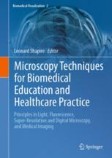Search
Search Results
-
Confocal and Multiphoton Microscopy
Confocal and multiphoton microscopy are considered advanced instruments in the field of light microscopy due to the complexity of the optical and...
-
Confocal Microscopy
Why optical sectioning is required to image thick fluorescent specimens How microscopists manage fluorescence blurring What we mean by ‘optical...
-
Confocal Scanning Laser Ophthalmoscopy to Image Retinal Ganglion Cells in Real-Time
Real-time imaging of retinal ganglion cells (RGCs) provides an opportunity for detailed investigation of retinal development, disease mechanisms, and...
-
Examination of gametocyte protein 22 localization and oocyst wall formation in Eimeria necatrix using laser confocal microscopy and scanning electron microscopy
BackgroundEimeria parasite infection occurs via ingestion of oocysts. The robust, bilayer oocyst wall is formed from the contents of wall-forming...

-
Confocal Laser Microscopy for VM Analysis with DAPI and Phalloidin Staining
Confocal laser scanning microscopy (CLSM) is one of the most prevalent fluorescence microscopy techniques for assessing the progression of cancer...
-
Confocal Laser Scanning Microscopy and Fluorescence Correlation Methods for the Evaluation of Molecular Interactions
Confocal laser scanning microscopy (CLSM) and related microscopic techniques allow a unique and versatile approach to image and analyze living cells...
-
Optical Activation of Photoswitchable TRPC Ligands in the Mammalian Olfactory System Using Laser Scanning Confocal Microscopy
The transient receptor potential canonical (TRPC) ion channels play important biological roles, but their activation mechanisms are incompletely...
-
High-speed multiplane confocal microscopy for voltage imaging in densely labeled neuronal populations
Genetically encoded voltage indicators (GEVIs) hold immense potential for monitoring neuronal population activity. To date, best-in-class GEVIs rely...

-
Advances in Microscopy and Its Applications with Special Reference to Fluorescence Microscope: An Overview
The microscope has revolutionized the understanding of an organism’s structural details and cellular functions. With the invention of highly evolved...
-
Bimolecular Fluorescence Complementation (BiFC) in Host–Virus Interactions
Bimolecular fluorescence complementation (BiFC) is an assay widely used for studying protein–protein interactions and determining the subcellular...
-
Bright New World: Principles of Fluorescence and Applications in Spectroscopy and Microscopy
The study of fluorescence has revolutionized biomedical research. Since it was first described almost two centuries ago, fluorescence has transformed...
-
Azimuthal Beam Scanning Microscope Design and Implementation for Axial Localization with Scanning Angle Interference Microscopy
Azimuthal beam scanning, also referred to as circle scanning, is an effective way of eliminating coherence artifacts with laser illumination in...
-
The intracellular visualization of exogenous DNA in fluorescence microscopy
In the development of non-viral gene delivery vectors, it is essential to reliably localize and quantify transfected DNA inside the cell. To track...

-
Morphometric Image Analysis and its Applications in Biomedicine Using Different Microscopy Modes
In biomedicine, morphometric image analysis is defined as the merging of geometry and histology. Morphometry refers to a quantitative analysis of the...
-
Spinning Disk Microscopy
Spinning disk microscopy is a specialized imaging technique utilized with living and light sensitive samples. Arrays of optical pinholes spun at high...
-

-
Stimulated Emission Depletion Microscopy
Stimulated emission depletion (STED) microscopy is in its simplest form an extension of confocal fluorescence microscopy that offers much enhanced...
-
A Three-Dimensional Primary Cortical Culture System Compatible with Transgenic Disease Models, Virally Mediated Fluorescence, and Live Microscopy
In vitro cell culture models can offer high-resolution and high-throughput experimentation of cellular behaviors. However, in vitro culture...
-
Fluorescence lifetime imaging and electron microscopy: a correlative approach
Fluorescence lifetime imaging microscopy (FLIM) allows the characterization of cellular metabolism by quantifying the rate of free and unbound...

-
Correlative Imaging to Detect Rare HIV Reservoirs and Associated Damage in Tissues
Correlative light-electron microscopy (CLEM) has evolved in the last decades, especially after significant developments in sample preparation,...
